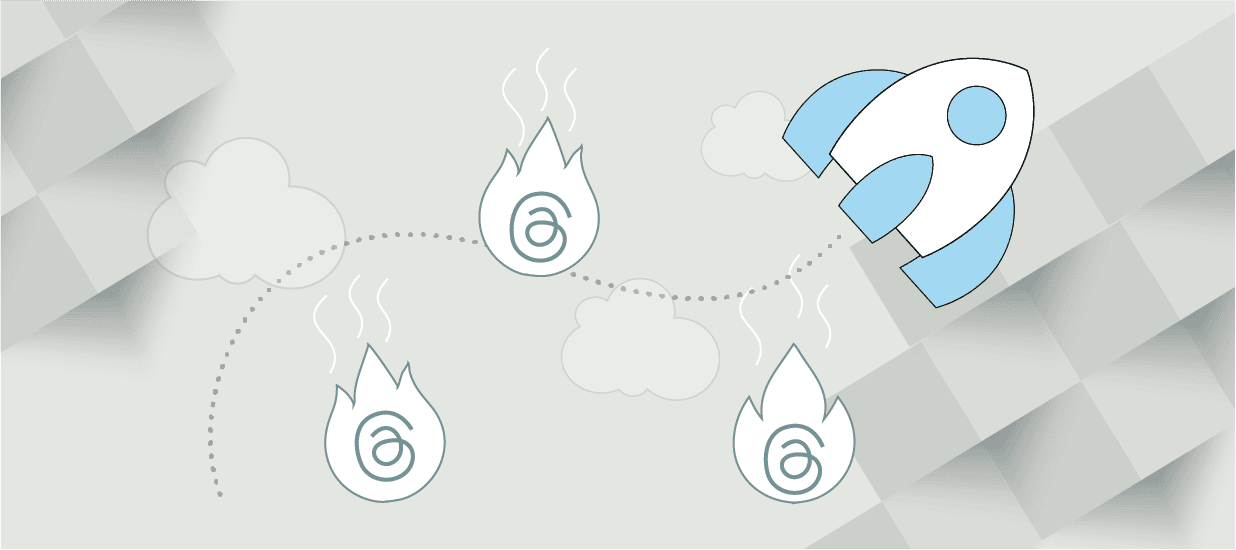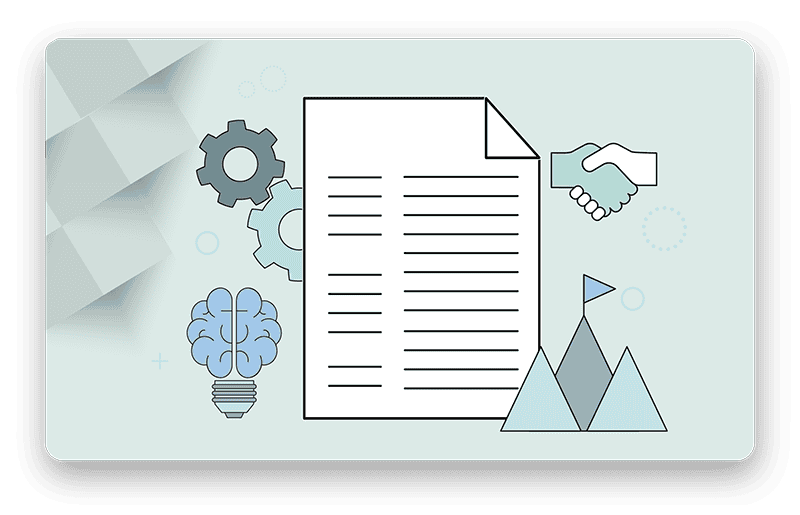11-minute read
Writing a product manager resume might seem intimidating, but key elements can help you curate a resume that highlights your skills and supports your job search. This article shares custom tips to help product professionals craft resumes for product manager job applications.
Product managers have many responsibilities. They are responsible for gathering information about market problems and opportunities, collaborating with cross-functional partners to develop satisfying products, and guiding products through every stage of the product life cycle. Because of these weighty responsibilities, skilled product managers are in high demand. If you are applying for product manager jobs, you need to stand out from other applicants.
An up-to-date, polished resume highlighting your skills can help you differentiate yourself from a crowded field. Read on for our best tips to help you create a product manager resume, or jump to the section that interests you:
- What to include in a product manager resume
- Free resume templates for product managers
- Tips for writing a resume
What to include in a product manager resume
Best practices for creating product manager resumes are similar to best practices for writing resumes for other jobs. Your resume will include many of the same elements, such as listing your past roles and responsibilities, noting educational experience and certifications, highlighting skills and knowledge, and demonstrating leadership and teamwork.
When you update your resume, you may include some information unique to your past roles or industry. Product manager resumes may have some slight differences from resumes for other roles. A product manager’s resume might highlight specific work that the product manager did to support their products at different stages of the product lifecycle. It may also highlight skills or tactics such as product strategy, roadmapping, or market research. Additionally, resumes may discuss roles or responsibilities associated with product methodologies like Agile or Scrum.
Personal Information
The personal information section contains your name and relevant personal information. is often at the top of the page and should be visually distinct from the rest of the resume. The personal information section might include your first and last name, the city where you live, your phone number, and potentially a LinkedIn URL. This section should be clean and easy to read because you want it to be clear whose resume the interview panel is looking at.
Do:
- Use a bigger font for your name to help it stand out.
- Include your name, phone number, email, and city.
- Link to your LinkedIn profile using a clear URL.
Don’t
- Include your personal street address (123 Main St., Anytown USA). It’s not necessary, so don’t compromise your safety by sharing it.
- Include photos of yourself or your date of birth unless they are requested
- Link to a personal website or product portfolio in this section. You can provide that in another section.
Work Experience
The work experience section of a product manager’s resume is arguably the most critical part and may be the most challenging to present well. It may be tempting to think your work speaks for itself or that your past job titles and companies you’ve worked for will communicate your value. Or, you might be hesitant to “brag” about your accomplishments. However, there’s no better place to show the breadth and depth of your experience and highlight the strong results you’ve driven.
You should organize this section in reverse chronological order, with your most recent role at the top. Include your title, the company you worked for, and the dates of your employment. If you are still in that role, you can put “Current” on your end-of-employment date. If you were laid off from a past role, don’t worry. You can still put the dates of your employment. If you have a gap in your work history, we recommend addressing that in a cover letter or during the interview process.
If you’re applying for a product manager role, this section of your resume should go beyond recapping your tasks and responsibilities and demonstrate your achievements. Highlight your expertise, your meaningful impact on your team or product, and how you drove results for the company. To do this, use clear, concise descriptions of what you did, using active verbs. Each bullet point should start with an action verb that communicates your responsibilities in past roles and should relate to the skills needed for the role you’re applying for. These points can be in the present or past tense, depending on whether they refer to current or past job achievements.
Whenever possible, quantify your achievements with relevant numbers and metrics. Attaching metrics to your work experience shows a prospective employer that you supported vital business goals and understand the importance of communicating those achievements. Ensure the metrics are clear and relevant to their associated skill, such as “spearheaded user experience improvements based on customer feedback, leading to a 15% increase in customer satisfaction”. This example uses an active verb to highlight what you did (“spearheaded user experience improvements”), how you did it (“based on customer feedback”), and why it mattered (“15% increase in customer satisfaction”).
Skills
Product managers cover a wide range of skills, so it may be difficult to include everything you accomplished in every role. Instead, focus on the most impactful things you did and tailor what you include to match most appropriately to your past roles and to the role you are applying for.
Technical Skills
Here are some examples of technical or hard skills you can highlight:
- Conducted thorough market research to identify emerging trends and opportunities.
- Crafted detailed product strategies that align with the company’s vision and market needs.
- Led the end-to-end product development process, ensuring the timely delivery of high-quality products.
- Facilitated collaboration among engineering, marketing, sales, and support teams to meet product goals.
- Prioritized features and tasks in the product backlog to align with strategic objectives.
- Utilized analytics and user feedback to drive continuous product improvements and innovations.
- Developed and executed go-to-market strategies, including pricing, marketing, and sales enablement.
- Established clear, achievable product performance metrics and led the team toward those goals.
- Engaged with customers and stakeholders to gather insights and feedback that informed product development.
- Advocated for user needs and worked closely with UX/UI teams to enhance product design and functionality.
Soft Skills
Soft skills are important to include on a product manager’s resume, although they may require more than technical or hard skills. That’s because they speak more about a person’s character or intangible assets than concrete skills. Here are some examples of soft skills for product managers:
- Communication: Articulate product vision and decisions to product teams, cross-functional collaborators, and stakeholders. Listen actively, interpret, and reshare information accurately.
- Leadership: Guide teams toward shared goals through decision-making, setting clear expectations, and motivating and supporting teammates.
- Empathy: Understand others’ feelings. Empathy is an essential interpersonal skill for product managers as they gather customer feedback and work with internal and external teams to work toward shared goals.
- Problem-Solving: Analyze problems, identify possible solutions, decide on the best path forward, and prioritize solutions. Product managers often face complex technical and logistical challenges that require creativity and strategic thinking.
- Negotiation: Compromise and find mutually beneficial solutions for problems, understanding that different teams and stakeholders may have competing interests.
- Time Management: Monitor and prioritize tasks with competing deadlines to ensure that the team reaches short-term and long-term goals.
- Adaptability: Anticipate and quickly respond to changing user needs, market conditions, team priorities, and technological or logistical challenges.
You can integrate your soft skills into your work experience along with your technical skills. For example, you might include something like “cleared a 6-month product backlog while balancing team prioritizes and stakeholder expectations”. As with technical skills, you should quantify your achievements to highlight the impact of your contributions. You can also highlight your soft skills when you communicate the purpose of a project, such as by saying, “Led an initiative to gather feedback from 20% of active customers to better understand pain points and user priorities”.
Regardless of whether you have a manager or supervisory role, it is always good to highlight your teamwork and leadership skills. You can integrate soft skills to show instances where you’ve led teams or projects across the finish line and highlight your positive contributions.
Many professionals applying for product manager jobs may be transitioning from other fields, like marketing or engineering. If you don’t have skills that directly translate to product management, highlight transferable and soft skills like leadership, strategic thinking, and problem-solving.
Do:
- Order your work experience in reverse chronological order.
- Use active verbs in the present or past tense, depending on whether it is a current or past role.
- Quantify your accomplishments and actions.
- Highlight critical skills for product managers and match them to the role you’re applying for.
- Show a balance of skills that are appropriate for your past roles.
Don’t:
- Undersell your skills. This is the time to sell yourself!
- Overwhelm your reader with math or statistics. When you quantify your achievements, make the numbers clear and concise.
- Load your resume with buzzwords or jargon.
- Embellish or lie about your responsibilities or achievements.
Education and Certifications
The education section is vital for any resume but is often less consequential than your past roles and responsibilities. In this section, you can highlight any degrees you completed, where you earned that degree, and the date range when you were enrolled. For example, you might share that you earned a Bachelor of Science in Information Technology from City University in 2018. If you’re new in your career or are a recent graduate, you can include more details about your educational experience, including relevant coursework you completed or any academic awards you received.
Seasoned professionals can highlight any continuing education you’ve completed, including product management training or certifications. Highlighting your professional training demonstrates to prospective employers that you’re interested in expanding your knowledge and skills and can set you apart from other candidates during the hiring process. In this section, you should include the name of the training or certification, the institution you received it from, and the date it was completed (such as May 2023).
Don’t have a college degree? Don’t worry. Many strong product managers have excelled in their careers without a college degree. Highlight any relevant educational experience you’ve gained, including professional training or certification programs.
Do:
- List each degree you’ve received chronologically, with the highest level of education presented first. For example, if you have a B.S. and an MBA, you should put the MBA first).
- For each degree, list the degree you received, the dates of your education, and the name of the institution.
- If you’re a recent graduate:
- List any courses that are relevant to product management.
- Include any academic awards you received and their level of competitiveness.
- List any trainings or certifications you completed, including the date of completion and the organization from which you received it (such as Pragmatic Institute).
Don’t:
- Include high school experience if you have already graduated.
- Include your thesis or dissertation topic unless you are a recent graduate or unless it demonstrates subject matter expertise relevant to the role you’re applying for. If you include it, summarize it clearly and concisely for a general audience.
LinkedIn and Websites
For many product management job seekers, showcasing your digital footprint is essential. In your resume, you can link to your LinkedIn profile so the hiring committee can quickly view your profile (and be sure that your profile is updated and accurate, with a URL that matches your name and profile). Product professionals may link their product portfolio; engineers may want to include their Github accounts. Product leaders may also want to highlight thought leadership platforms like Medium or Substack. Regardless of what you link to, ensure that the link URL is descriptive and distinct, including your first and last names, so it’s clear what they are looking at.
Do:
- Ensure that any link is easy to understand and is work-appropriate.
- Make sure that your LinkedIn, portfolio website or other profiles are updated and your work experience matches the resume you are submitting.
Don’t:
- Panic if you don’t have a product portfolio website. If you’re early in your career, you may not have one yet.
- Rush to create a portfolio if you don’t have one. It’s better not to share one than to share one that seems rushed.
Additional Skills and Interests
Product managers must use various tools, technologies, and methodologies in their daily work. These can be loosely grouped into the following categories:
- Product Management:Asana, Monday.com, Jira, Basecamp
- Analytics: Google Analytics, Microsoft Clarity, Adobe Analytics
- Data Visualization: Tableau, Looker Studio, PowerBI
- Methodology: Agile, Scrum, Kanban, Pragmatic Framework
- Programming Languages: Python, Java, C/C++, CSS, HTML, and R
The additional interests and skills section is also an excellent place to highlight other reasons you’re a strong candidate for the role. For example, you could highlight any languages you speak (and indicate your fluency) or highlight interests or volunteer experience that would set you apart from the crowd. You may also find opportunities to showcase your personality and sense of humor.
Product Manager Resume Templates
Streamline your job search with resume templates made just for product managers. Once you complete the form, we’ll deliver the resume templates to your email. You can download the templates as Word documents, edit them with your resume information, and use them as you apply for jobs. Good luck!
Tips for Writing a Product Manager Resume
You will want to adapt your resume for each job you apply for. We recommend making an “evergreen” resume that you can customize based on the role’s requirements. You may even want to over-write your resume so you have information ready to pare down for the appropriate role.
Tailoring your resume to the job application
When you are preparing your resume for a job application, do some research. Look at job listings that are typical for your desired job. Are there any common skills or role requirements? A word of caution is that although the job title might be “Product Manager,” responsibilities can vary between teams, organizations, and fields.
When possible, match the language you use to describe your work experience, past responsibilities, and technical and soft skills in the language used in the job posting. Matching keywords in your resume to the job description can help applicant tracking systems (ATSs) understand that your resume is a strong match for the job. Once you get past the initial screening, a tailored resume can signal to human hiring panels that you are a strong candidate.
You should also research the company and learn its core values and vision. When possible, tailor your resume to reflect those characteristics. Matching them in your resume may be challenging, but you can highlight past roles, responsibilities, and skills that support those values.
Formatting your resume
Choose a professional layout. You can set apart elements like your name or the header section of your resume in a different color to show some personality and help your resume stand out. Be sure to keep your resume professional and accessible. Usually, your resume should be formatted to fit the layout of one 8 ½ by 11-inch digital document. This is a standard format for resumes, and it allows hiring managers to view your entire resume on one screen without scrolling. Don’t go overboard with a stylized resume unless you’re a designer.
You should present important information in black type, in a professional font like Times New Roman, Arial, or Aptos. Use bullet points for lists of information. Ensure that your resume looks full but not overcrowded – leave enough white space so your reader isn’t overwhelmed. Triple-check the formatting to make sure everything displays as you intended. When you submit your resume, save it as a PDF to help prevent formatting issues between software (like from Google Docs to Word). You should also clearly label your resume with your name, “Resume,” and the date. Submitting a resume titled “resume_v1 (1)” looks unprofessional.
Writing your cover letter
While cover letters are often not required, submitting a cover letter with your resume can help your application stand out in a crowded field. Cover letters allow you to add detail beyond your work experience, education, and skills. It also lets you showcase your passion for product, share insight into your soft skills, and demonstrate why you’re a good fit for the team and company. The cover letter is also an opportunity for applicants with gaps in work history or who are transitioning from other fields to provide details about why they are strong candidates, even if they may only fulfill some of the qualifications of the job description.
If you submit a cover letter, use a format like your resume. Make it clear that the cover letter accompanies your resume in the application (this includes choosing a concise, descriptive name for the file when you submit it). Keep your cover letter to one page or less. Ensure you add valuable detail to the cover letter; do more than restate the information you already have in your resume. As with your product manager resume, tailor your cover letter to the job description and organization you are applying for.
Proofing and Feedback
Proofreading is often the last step in creating a resume, but it’s the most critical step. Use spelling and grammar check tools in Word and Google Docs or use Grammarly. Proofread every time you make changes to your resume (and remember to check for formatting issues when you make changes). Print a copy of your resume to proofread it on paper if possible. It sounds old school, but you may catch errors you may not recognize on a digital file.
Ask for feedback on your resume. Ask a trusted mentor, colleague, or friend to review your resume for errors and give honest, actionable feedback. They will likely spot issues or opportunities that you may not have noticed. It may feel vulnerable, but getting a second opinion will only strengthen your resume against the applicant pool.
Summary
Crafting a tailored resume for each job application can be daunting, but with the right preparation and tools, you can create a stellar resume that helps you stand out from the crowd of applicants. Be sure to track the roles and companies you apply for, the date you applied, and note any follow-up steps (like if you are contacted for a first-round interview). Gathering data about the application process will help you become more efficient over time.
Be sure to check out our other resources to help you prepare for interviews and forge a career as a product manager.
- 7 Critical Product Manager Interview Tips
- 50+ Product Manager Interview Questions (With Answers)
- Top Reasons to Pursue a Product Management Certification
Author
-

The Pragmatic Editorial Team comprises a diverse team of writers, researchers, and subject matter experts. We are trained to share Pragmatic Institute’s insights and useful information to guide product, data, and design professionals on their career development journeys. Pragmatic Institute is the global leader in Product, Data, and Design training and certification programs for working professionals. Since 1993, we’ve issued over 250,000 product management and product marketing certifications to professionals at companies around the globe. For questions or inquiries, please contact [email protected].
View all posts








